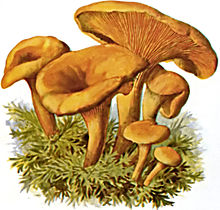Hygrophoropsidaceae
Hygrophoropsidaceae | |
|---|---|
 | |
| False chanterelle, Albin Schmalfuß, 1897 | |
Scientific classification | |
| Kingdom: | Fungi |
| Division: | Basidiomycota |
| Class: | Agaricomycetes |
| Order: | Boletales |
| Family: | Hygrophoropsidaceae Kühner (1980) |
Type genus | |
Hygrophoropsis (J.Schröt.) Maire ex Martin-Sans (1929) | |
Genera | |
Hygrophoropsis | |
The Hygrophoropsidaceae are a family of mushrooms that are gilled in appearance but lie within the Boletales. The family contains 18 species within two genera:[1]Leucogyrophana and Hygrophoropsis, with the best-known member being the "false chanterelle", Hygrophoropsis aurantiaca. Hygrophoropsidaceae was circumscribed by French mycologist Robert Kühner in 1980, with Hygrophoropsis as the type genus.[2] Unlike most members of the Boletales, Hygrophoropsidaceae species are saprophytic wood-rotting fungi that cause brown rot in their hosts.[3] The genera Austropaxillus and Tapinella, once placed in this family,[4] are now classified in the Serpulaceae[5] and Tapinellaceae,[6] respectively.
References
^ Kirk PM, Cannon PF, Minter DW, Stalpers JA (2008). Dictionary of the Fungi (10th ed.). Wallingford, UK: CAB International. p. 326. ISBN 978-0-85199-826-8..mw-parser-output cite.citation{font-style:inherit}.mw-parser-output .citation q{quotes:"""""""'""'"}.mw-parser-output .citation .cs1-lock-free a{background:url("//upload.wikimedia.org/wikipedia/commons/thumb/6/65/Lock-green.svg/9px-Lock-green.svg.png")no-repeat;background-position:right .1em center}.mw-parser-output .citation .cs1-lock-limited a,.mw-parser-output .citation .cs1-lock-registration a{background:url("//upload.wikimedia.org/wikipedia/commons/thumb/d/d6/Lock-gray-alt-2.svg/9px-Lock-gray-alt-2.svg.png")no-repeat;background-position:right .1em center}.mw-parser-output .citation .cs1-lock-subscription a{background:url("//upload.wikimedia.org/wikipedia/commons/thumb/a/aa/Lock-red-alt-2.svg/9px-Lock-red-alt-2.svg.png")no-repeat;background-position:right .1em center}.mw-parser-output .cs1-subscription,.mw-parser-output .cs1-registration{color:#555}.mw-parser-output .cs1-subscription span,.mw-parser-output .cs1-registration span{border-bottom:1px dotted;cursor:help}.mw-parser-output .cs1-ws-icon a{background:url("//upload.wikimedia.org/wikipedia/commons/thumb/4/4c/Wikisource-logo.svg/12px-Wikisource-logo.svg.png")no-repeat;background-position:right .1em center}.mw-parser-output code.cs1-code{color:inherit;background:inherit;border:inherit;padding:inherit}.mw-parser-output .cs1-hidden-error{display:none;font-size:100%}.mw-parser-output .cs1-visible-error{font-size:100%}.mw-parser-output .cs1-maint{display:none;color:#33aa33;margin-left:0.3em}.mw-parser-output .cs1-subscription,.mw-parser-output .cs1-registration,.mw-parser-output .cs1-format{font-size:95%}.mw-parser-output .cs1-kern-left,.mw-parser-output .cs1-kern-wl-left{padding-left:0.2em}.mw-parser-output .cs1-kern-right,.mw-parser-output .cs1-kern-wl-right{padding-right:0.2em}
^ Kühner R. (1980). "Les Hyménomycètes agaricoides". Bulletin Mensuel de la Société Linnéenne de Lyon (in French). 49: 900.
^ Kibby G. (2012). "The Hygrophoropsis aurantiaca complex". Field Mycology. 13 (2): 43–50. doi:10.1016/j.fldmyc.2012.03.004.
^ Kirk PM, Cannon PF, David JC, Stalpers JA (2001). Ainsworth & Bisby's Dictionary of the Fungi (9th ed.). Oxon, UK: CABI Bioscience. pp. 53, 514. ISBN 978-0-85199-377-5.
^ "Austropaxillus Bresinsky & Jarosch". Index Fungorum. CAB International. Retrieved 2015-11-22.
^ "Tapinella E.-J. Gilbert". Index Fungorum. CAB International. Retrieved 2015-11-22.
This Boletales-related article is a stub. You can help Wikipedia by expanding it. |